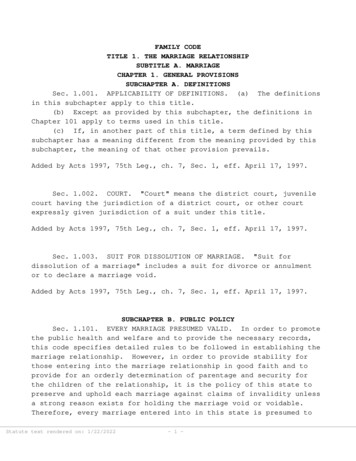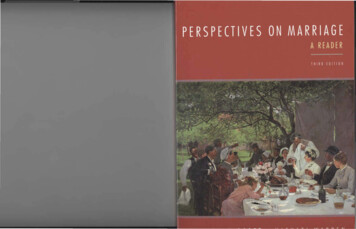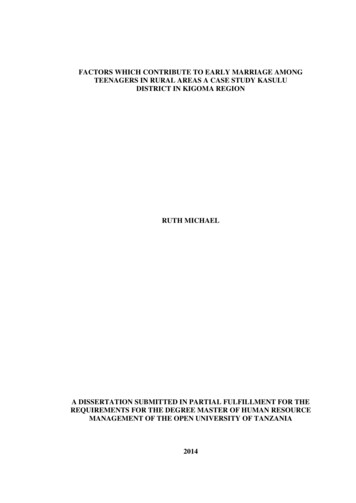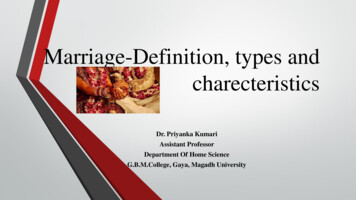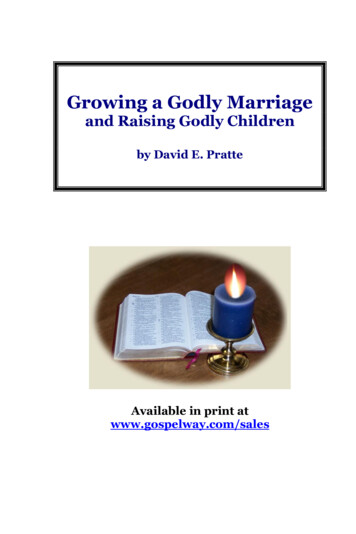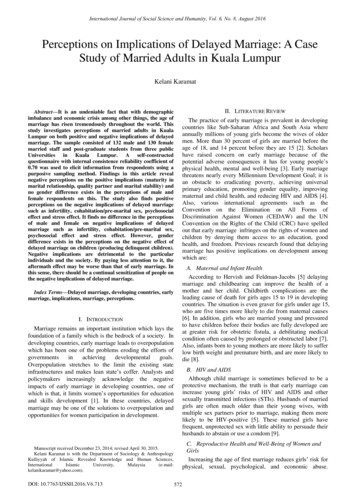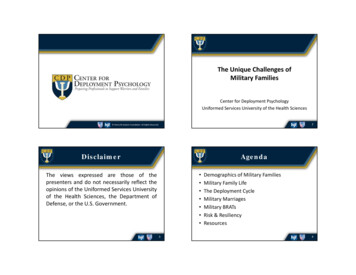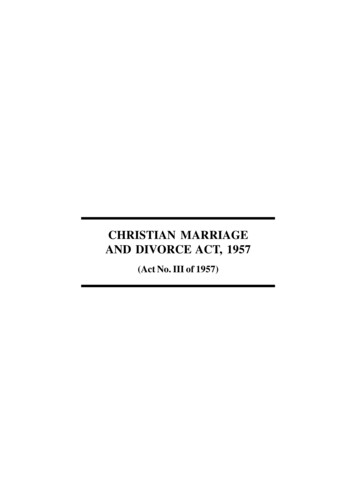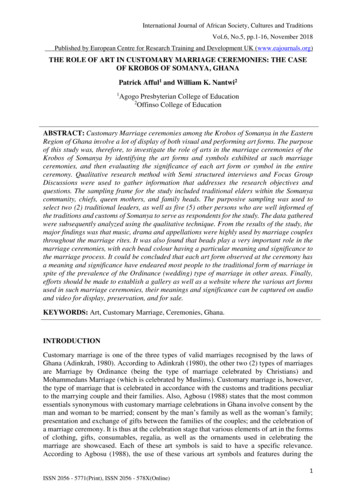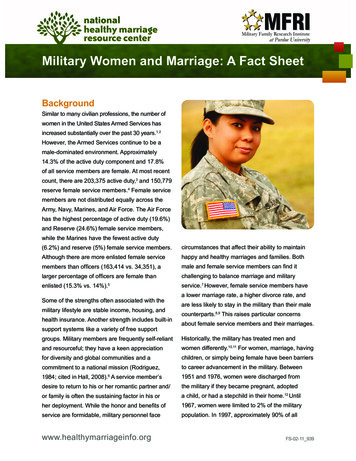
Transcription
Military Family Research Instituteat Purdue UniversityMilitary Women and Marriage: A Fact SheetBackgroundSimilar to many civilian professions, the number ofwomen in the United States Armed Services hasincreased substantially over the past 30 years.1,2However, the Armed Services continue to be amale-dominated environment. Approximately14.3% of the active duty component and 17.8%of all service members are female. At most recentcount, there are 203,375 active duty,3 and 150,779reserve female service members.4 Female servicemembers are not distributed equally across theArmy, Navy, Marines, and Air Force. The Air Forcehas the highest percentage of active duty (19.6%)and Reserve (24.6%) female service members,while the Marines have the fewest active duty(6.2%) and reserve (5%) female service members.circumstances that affect their ability to maintainAlthough there are more enlisted female servicehappy and healthy marriages and families. Bothmembers than officers (163,414 vs. 34,351), amale and female service members can find itlarger percentage of officers are female thanchallenging to balance marriage and militaryenlisted (15.3% vs. 14%).service.7 However, female service members have5Some of the strengths often associated with themilitary lifestyle are stable income, housing, andhealth insurance. Another strength includes built-insupport systems like a variety of free supporta lower marriage rate, a higher divorce rate, andare less likely to stay in the military than their malecounterparts.8,9 This raises particular concernsabout female service members and their marriages.groups. Military members are frequently self-reliantHistorically, the military has treated men andand resourceful; they have a keen appreciationwomen differently.10,11 For women, marriage, havingfor diversity and global communities and achildren, or simply being female have been barrierscommitment to a national mission (Rodriguez,to career advancement in the military. Between1984; cited in Hall, 2008). A service member’s1951 and 1976, women were discharged fromdesire to return to his or her romantic partner and/the military if they became pregnant, adoptedor family is often the sustaining factor in his ora child, or had a stepchild in their home.12 Untilher deployment. While the honor and benefits of1967, women were limited to 2% of the militaryservice are formidable, military personnel facepopulation. In 1997, approximately 90% of all6www.healthymarriageinfo.orgFS-02-11 939
military occupations are open to women.13,14 TheNational Guard – The Guard serves states as wellnumber of available occupations continues toas the federal government (called a dual-statusincrease, with female service members recentlyorganization).22 Each state has its own Nationalbeing assigned to serve on submarines for theGuard, under the control of the Governor, althoughfirst time. Although the official barriers for femalethe President can request the services of the Guard.service members have been decreasing, womenMembers of the Guard typically serve part-time,in the military still face unofficial challenges andexcept when they are activated to full-time duty.barriers related to serving in a traditionally maledominated military.The Reserves – All branches of the Armed Forcesinclude Reserves, with Reservists typically servingThe military places many demands on its malethe military part-time while also maintaining civilianand female service members (e.g., lengthyemployment. When activated, Reservists willdeployments, mandatory moves). These demandsusually serve the military full-time, and then returncan make it difficult to meet family needs. Forto part-time service when deactivated.example, the primary reason Navy Junior Officersreport leaving the Navy is because their work andpersonal goals conflict.15 Traditionally, family lifealso places many demands on women, as theyDual-military Couples – Dual-military couplesare married couples with both spouses serving inthe military.23tend to perform the majority of housework and haveMilitary Sexual Trauma (MST) – Sexualprimary responsibility for taking care of children.16harassment that is threatening in nature or physicalBalancing married life and a military career in aassault of a sexual nature that occurred while thetraditionally male-dominated environment posesvictim was in the military.24challenges for female service members that maleservice members do not face.17 These challengesextend to the husbands of female service membersMarriage Rates and Trends(e.g., finding new employment after a move).18,19Research on the effects of military life on the familyHowever, husbands may receive less supportlives of female service members is not readilyfrom the military and less social support than theavailable. When evaluating the marriages of femalewives of male service members.20 If military womenservice members, practitioners should recognizestruggle to balance competing military and familythat women in the military face more challengesroles, they may be forced to choose between theirthan their male counterparts by trying to balancemarriage and their military career.family life with an extremely demanding job. Bothat work and at home, female service membersDefinitionsActive Duty – When service members serve inthe military as full-time employment, regardless oftheir branch of service, they are considered to beon active duty.21www.healthymarriageinfo.orgchallenge traditional gender roles.Women in the military are less likely to be marriedthan their male counterparts. However, thereason for this disparity is unclear. One possibleexplanation is that the military benefits for marriedservice members were designed with male serviceFS-02-11 939
members in mind and may not be as supportiveof married female service members. Conversely,female service members may choose to delaymarriage, so that they can get ahead in theirmilitary careers. Female service members mayview marriage and family life to be a deterrent totheir military career aspirations. Male service members are more likely to bemarried than female service members (56.6%vs. 46.2%). This gender difference is particularlypronounced when looking at only active dutyservice members (88% of active duty males aremarried vs.12% of active duty females).25 The Air Force has the highest rate of marriage(51.2%) for female service members amongthe four branches of the military. The Armyfollows the Air Force with a rate of 47%, theMarine Corps has a rate of 41.3% and theNavy has the lowest rate of marriage of 39.9%among female service members.26 support healthy marriages (e.g., counseling andmarriage education), so that service memberscan maintain healthy families while meeting thedemands of military life. It is unclear whether theseresources meet the unique needs of the spouses offemale service members.6.7% of all active duty service members are indual-military marriages. Female service members have higher rates of dual-military marriagesthan male service members (22.4% vs. 4.1%).Of female service members who are married,48.4% are in dual-military marriages.27 healthcare, housing allowances, and services thatMilitary Sexual Trauma (MST)and Domestic ViolenceApproximately 20% to 43% of female servicemembers and veterans experienced military sexualSome evidence suggests that servicetrauma. Risk factors for women experiencingwomen with civilian husbands had unhappiermilitary sexual trauma include: entering the militarymarriages and a higher risk of maritalat a young age; enlisted rank versus officer rank;separation than male service members withand experiencing childhood physical or sexualcivilian spouses.assault. Female service members have been found28The military has recognized the importance offamily life to service members, especially sincedifficulty in meeting family needs is a primaryreason service members leave the military.29,30Consequently, the military has invested substantialresources into providing services such aswww.healthymarriageinfo.orgto have higher rates of childhood sexual assaultthan their civilian counterparts.31 Women whoexperience MST are at higher risk for physical andmental health problems, such as post traumaticstress symptoms.32, 33,34Like other women, female service members mayFS-02-11 939
be victims of domestic violence. In one study,It is important for service providers to educate21.6% of active duty women experienced physicalthemselves about the unique challenges thator sexual assault at the hands of their partnersfemale service members face. Female serviceduring their military service. Domestic violencemembers are a minority in the military population,39in military relationships is an area of concernand based on the disparity in divorce rates betweenamong military professionals. The probabilitythem and their male counterparts,40 it appearsthat active duty men and women in the Armythat the families of female service members facewill commit severe spousal aggression uponunique challenges. Service providers need to bereturn from deployment increases as the lengthaware of these challenges, due to their minority35of the deployment increases.36Female Armyposition in a traditionally male military environment.service members are more likely to be violentFurthermore, women’s military experience maywith unemployed civilian spouses than employedhave included incidents of military sexual traumacivilian spouses.37which may have a negative impact on intimacy.Consequently, service providers need to be flexible,Divorce Rates and Trendsand recognize that their services may need to beA study of divorce trends in the military found thatfrom couples with military husbands in order torates of divorce among female service membersassist female service members and their partners.were twice those of male service members (7.7%vs. 3%). Speculations about the reasons for thisdisparity include: the military attracts females whoare at a higher risk for divorce irrespective of theiremployment;38 the difficulties that female servicemembers and their families might encounterbalancing military and family life; and a lack ofavailability of services specifically tailored for thespouses of female service members. There is noconclusive explanation for the substantial disparityin rates of divorce between men and women in thetailored in ways that differ from civilian couples andThe demands placed on military families maybe heightened for women in the Armed Forcesin some circumstances. When working withmilitary couples in which both partners are servicemembers or only the woman is a service member,it is necessary for policymakers and practitioners toconsider the special issues that may arise. At thistime, there is little to no research on the effects ofhome life for females in the military, suggesting aneed for further research in the area.military. However, this study underscored concernsabout the significant challenges that marriedfemale service members may face. For example,female service members are much more likely tobe in dual-military couples, facing the additionalchallenges of balancing two military careers withfamily life.Female service members and their spousesAdditional ResourcesFor military couples: Military OneSource (800-342-9647) Each branch of the military offers familysupport services:may seek services individually or as a couple toArmyhelp achieve and maintain a healthy marriage.Navywww.healthymarriageinfo.orgFS-02-11 939
Air ForceMarine Corps Military Mental Health American Association for Marriage and FamilyTherapy therapist locator Community Mental Health Clinics Military chaplains and local clergy(2010). Profile of the military community: DoD 2008demographics. Alexandria, VA: ICF International.5ibid6Eugenia L. Weiss, Jose E. Coll, Jennifer Gerbauer,Kate Smiley and Ed Carillo The Family Journal2010 18: 395 The Military Genogram: A SolutionFocused Approach for Resiliency Building in ServiceMembers and Their Families http://tfj.sagepub.com/content/18/4/395.7Mutter, C. A., Aspy, C. L., Duniphan, J. P., Ford, B.F., Hamre, J. P., Horner, H., Patane, S. L., Pattillo,D. L., Robson, M., Rowell, V., & Silberman, R.(2003). Defense Department Advisory Committee onWomen in the Services (DACOWITS) 2003 Report.Washington, DC: Department of Defense.8Karney, B. R. & Crown, J. S. (2007). Families understress: An assessment of data, theory and researchon marriage and divorce in the military. Santa Monica,CA: Rand National Defense Research Institute.9Defense Manpower Data Center (2003). 2002Active Duty Status of Forces Survey: OverviewBriefing. Retrieved October 28, 2010 from ort/2003/d20030225sofa.pdfFor service providers: Center for Deployment Psychology Give an Hour Contact your state’s National Guard FamilyProgram Become a Tricare providerThe National Healthy Marriage Resource Center(NHMRC) would like to thank Abigail Christiansen andKenona Southwell of the Military Family ResearchInstitute at Purdue University for their contributionsto this Fact Sheet. This is a product of the NHMRC,led by co-directors Mary Myrick, APR, and JeanetteHercik, PhD, and project manager Rich Batten, ThM,MEd, CFLE.10 Harrell, M. C., Beckett, M. K., Chien, C. S., &Sollinger, J. (2002). The status of gender integrationin the military: Analysis of selected occupations.Santa Monica, CA: Rand.11 Harrell, M. C. & Miller, L. L.Data Sources1Harrell, M. C., Beckett, M. K., Chien, C. S., &Sollinger, J. (2002). The status of gender integrationin the military: Analysis of selected occupations.Santa Monica, CA: Rand, National DefenseResearch Institute.2Harrell, M. C. & Miller, L. L. (1997). New opportunitiesfor military women. Santa Monica, CA: Rand,National Defense Research Institute.3Defense Manpower Data Center. (2010). Militarypersonnel information. Retrieved on October 13,2010, from top.htm4Deputy Under Secretary of Defense, MilitaryCommunity and Family Policy [DUSD (MC&FP)].www.healthymarriageinfo.org12 Women’s Research and Education Institute (2004).Chronology of significant legal & policy changesaffecting women in the military: 1947-2003.Retrieved October 25, 2010, from http://www.wrei.org/projects/wiu/wim/wim chron01.pdf13 Harrell, M. C. & Miller, L. L.14 Harrell, M. C., Werber Castaneda, L., Schirmer,P., Hallmark, B. W., Kavanagh, J., Gershwin, D.,Steinberg, P. (2007). Assessing the assignmentpolicy for Army women. Santa Monica, CA: RandNational Defense Research Institute.15 Barrett, K.(2010) Navy Task Force Life/Work.Retried November 23, 2010 from -4181-AAC22788C436A22C/0/TFLWBRIEF.pptFS-02-11 939
16 Bartley, S. J., Blanton, P. W., Gilliard, J. L. (2005).Husbands and wives in dual-earner marriages:Decision-making, gender role attitudes, divisionof household labor, and equity. Marriage & FamilyReview, 37, 69- 94. doi: 10.1300/J002v37n04 05.29 Mutter, C. A., et. al.17 Segal, M.W. (1999). Gender and the military.In J Saltzman Chafetz (Ed.), Handbook of thePsychology of Gender (pp. 563-581). New York, NY:Plenum.31 ibid18 Cooke, T. J., & Speirs, K. (2005). Migration andemployment among the civilian spouses of militarypersonnel. Social Sciences Quarterly, 86, 343-355.19 Little, R.D., & Hisnanick, J.J. (2007). Theearnings of tied-migrant military husbands.Armed Forces & Society, 33, 547-570. doi:10.1177/0095327X0629873220 Segal, M. W., & Segal, D. R. (2003). Implications formilitary families of changes in the armed forces of theUnited States. In G. Cafario (Ed.), Handbook of MilitarySociology (pp. 225-233). London, England: Sage.21 Deputy Under Secretary of Defense, MilitaryCommunity and Family Policy [DUSD (MC&FP)].(2010). Profile of the military community: DoD 2008demographics. Alexandria, VA: ICF International.22 National Guard 2010. http://www.ng.mil/About/default.aspx23 Segal, M.W. (1986). The military and the family asgreedy institutions. Armed Forces & Society, 13, 9-38.30 Orthner, D. K., & Pittman, J. F. (1986). Familycontributions to work commitment. Journal ofMarriage and the Family, 48, 573-581.32 ibid33 Martin, L., Rosen, L. N., Durand, D. B., Knudson, K.H., & Stretch, R. H. (2000). Psychological and physicalhealth effects of sexual assaults and nonsexualtraumas among male and female United States Armysoldiers. Behavioral Medicine, 26, 23–33.34 Shipherd, J., Pineles, S., Gradus, J., & Resick,P. (2009). Sexual harassment in the Marines,Posttraumatic stress symptoms, and perceivedhealth: Evidence for sex differences. Journal ofTraumatic Stress, 22, 3-10. doi: 10./1002/jts.2038635 Campbell, J., Garza, M., Gielen, A., O’Campo, P.,Kub, J., Dienemann, J., Jones, A., & Jafar, E. (2003).Intimate partner violence and abuse among activeduty military women. Violence Against Women, 9,1072-1092. doi: 10.1177/107780120325529136 McCarroll, J., Ursano, R., Liu, X., Thayer, L.,Newby, J., Norwood, A., & Fullerton, C. (2010).Deployment and the probability of spousalaggression by U.S. Army soldiers. Military Medicine,175, 352- 356.24 Department of Veterans Affairs (2004).Military sexual trauma (Independent studycourse). Retrieved from http://www.publichealth.va.gov/docs/vhi/military sexual trauma.pdf37 Newby, J., Ursano, R., McCarroll, J., Martin, L.,Norwood, A., & Fullerton, C. (2003). Spousalaggression by U.S. Army female soldiers towardemployed and unemployed civilian husbands.American Journal of Orthopsychiatry, 73, 288-293.doi: 10.1037/0002-9432.73.3.28825 Deputy Under Secretary of Defense, MilitaryCommunity and Family Policy [DUSD (MC&FP)].38 Karney, B. R. & Crown, J. S.26 ibid27 ibid28 Bowen, G. L., Orthner, D. K., Zimmerman, L. I., &Meehan, T. (1992). Family patterns and adaptationin the U.S. Army. Research Triangle Park, NC:Research Triangle Institute.www.healthymarriageinfo.org39 Deputy Under Secretary of Defense, MilitaryCommunity and Family Policy [DUSD (MC&FP)].(2010). Profile of the military community: DoD 2008demographics. Alexandria, VA: ICF International.40 Karney, B. R. & Crown, J. S.FS-02-11 939
support healthy marriages (e.g., counseling and marriage education), so that service members can maintain healthy families while meeting the demands of military life. It is unclear whether these . Military OneSource (800-342-9647) Each branch of the military offers family support services: Army Navy. www.healthymarriageinfo.org FS-02 .
